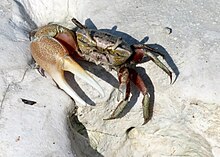Fiddler crab
A fiddler crab, also called a calling crab, is a land crab that lives in mud or sand flats near the beach. The reason this crab is called a fiddler crab is because it holds its large cheliped in front of its body and moves it back and forth as if it is playing a fiddle.[1]
| Fiddler crab | |
|---|---|

| |
| Uca pugnax | |
| Scientific classification | |
| Kingdom: | |
| Phylum: | |
| Subphylum: | |
| Class: | Malacostraca
|
| Order: | Decapoda
|
| Infraorder: | |
| Family: | Ocypodidae
|
| Genus: | Uca William Elford Leach, 1814
|
Description change
The male fiddler crab has one huge cheliped and another smaller cheliped. Sometimes it's the right cheliped that's the big one and sometimes it's the left. If a male loses its large cheliped, the smaller one will grow large to replace it. This huge cheliped is so large that it is sometimes bigger than the whole crab. It is this cheliped they wave back and forth.
Fiddler crab's diet change
The fiddler crab eats by first opening its mouth, then using its maxillipeds (a part of its mouth), it scoops in a small amount of mud or sand, depending on where it lives. Then, it uses its other mouthparts to scrape any food matter (algae, decaying animals or plants)it can from the dirt it has just put into its mouth. After this, it forms the mud or sand into a little pellet, which is called a feeding pellet. It then drops the feeding pellet and starts all over again.
Mating change
The reason the male fiddler crab has such a big claw is to attract females. Every two weeks during the summer, male fiddler crabs build little round burrows, which are deeper and better than the ones they usually build. The crabs guard these burrows fiercely. Where there are lots of fiddler crabs, there are usually hundreds of these little burrows all lined up only a few inches apart.[1] Each male fiddler crab stands out in front of his burrow waiting for the females to return from eating. The females then walk around looking at the different burrows. As they walk past, the males wave their big chelipeds back and forth. If a female likes a male or burrow, she will stop and stare. Then the male begins waving his cheliped wildly. Sometimes the female will run away. However, if she stays, the male will run between her and the burrow, back and forth, again and again.[1] If she has still not run away, she will come closer to the burrow. Then the male will enter the burrow a little and start drumming against the side of the tunnel with his cheliped.[1] If the female likes what she hears, she will go down into the burrow, and they will mate.
References change
- ↑ 1.0 1.1 1.2 1.3 Fulbright, Jeannie K. (2006). Exploring Creation with Zoology 2. 1106 Meridian Plaza, Suite 220: Apologia Educational Ministries, Inc. ISBN 1-932012-73-7.
{{cite book}}: CS1 maint: location (link)
Other websites change
- [1] Archived 2009-04-14 at the Wayback Machine - Videos of Fiddler Crabs
- Info on systematics, phylogeny and morphology of fiddlers - Fiddlercrab.info
- The colorful fiddler crabs in the mangrove forest of Borneo - mysabah.com